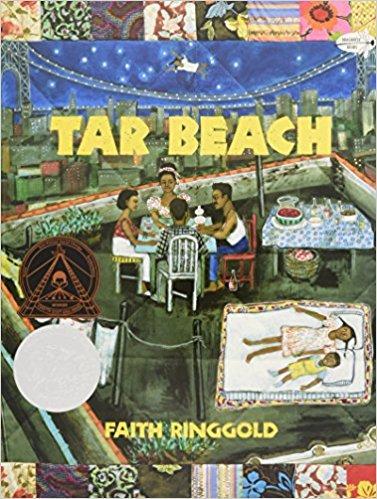
Tar Beach
Read Aloud Book: Tar Beach
Story: Angeline Sparagna LoPresti
Illustration: Phyllis Hornung
ISBN-13: 978-0780768567
C3 Framework Key term: Unemployment: A condition where people at least 16 years old are without jobs and actively seeking work.
Handouts
Poster handout (PDF version only)
Download and Print the PDF
Synopsis
Cassie lives in Harlem with her parents and brother. On hot summer nights, she likes to spend time on the roof with her family. She likes to dream that she is flying above the tall buildings of New York City. Flying above a building is a way of becoming an owner—a solution to her parents’ concerns about employment and income.
Discussion
Check for comprehension: What is Tar Beach? Affirm: Tar Beach is the black tar roof where Cassie’s family spent time in the summer. At those times in East Harlem, many people would spread their blankets on the rooftops and sunbathe as though they were on the beach. Provide context for the story by saying: Cassie was born in 1931; she grew up during the Great Depression. During that time, many people lost their jobs and had trouble finding work. African-American workers like Cassie’s father were not protected by the labor union. African American employees worked for lower wages and benefitted less than white people from President Roosevelt’s New Deal laws, which provided economic support to people in need. The New Deal proposed a new social policy at the federal level (as opposed to the state or county level). It focused on the needs of specific groups including the unemployed, women, children, laborers, and artists.
Ethics Connection
Say: Cassie’s father was hoping to join the union one day, to be better protected by the union agreements with employers. During the Great Depression, several court cases dealt with issues concerning workers’ rights to a fair wage and healthy working conditions. Show the 3-minute video about the Liberty of Contract, which protected employers. Say: Today, we will conduct debates based on a true court case. Share the facts: Joseph Tipaldo was the manager of a laundry business in New York. He paid nine laundry women only $10 a week, in violation of the New York State minimum wage law, which aimed to reduce exploitation of women by paying them an unreasonable wage which does not reflect the work value and amount of labor. When forced to pay his workers $14.88, Tipaldo forced the women to pay the difference. When Tipaldo was jailed on charges of violating the State law, his lawyers argued that the law was unconstitutional and the wage Tipaldo paid met the minimum cost of living necessary for health. The Supreme Court voided the law as a violation of liberty of contract. Say: In your table group divide up, so some will support the prosecutor (representing Tipaldo), and some will take the side of the defender (the state of New York).
Fun Activity
Distribute the poster handout (included in this lesson plan). Say: Design a poster about workers’ rights. You may address one or more of the following topics: minimum wage, the maximum number of hours per week, a safe work environment free of potential hazards, and the right to become a union member. You may add illustrations, but you should focus on the message. Your message should include at least one of the following: 1. A list of rights workers should have; 2. Facts and statistics related to the importance of workers’ rights; 3. The meaning of “Equal opportunities employer.”